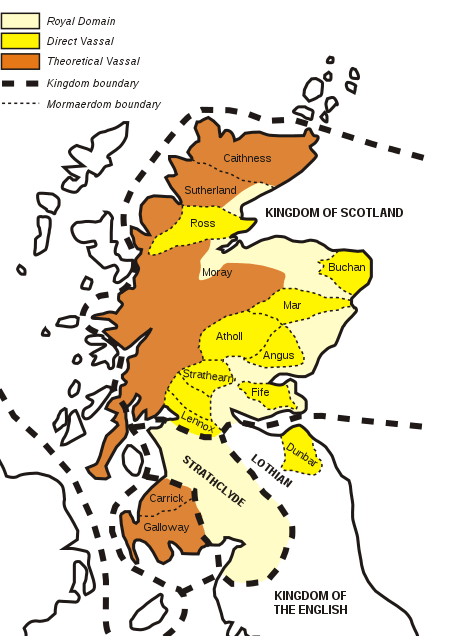Mormaer
In early medieval Scotland, a mormaer was the Gaelic name for a regional or provincial ruler, theoretically second only to the King of Scots, and the senior of a Taoiseach (chieftain). Mormaers were equivalent to English earls or Continental counts, and the term is often translated into English as 'earl'.
Etymology
The Gaelic term mormaer may represent a survival of a Pictish compound form.[1] The first element may be mɔ:r meaning "big, great, large" (c.f. Welsh mawr), and the second majr meaning "steward" (< Latin major).[1]
Earliest mormaers
The office of mormaer is first mentioned in the context of the Battle of Corbridge (918), in the Annals of Ulster. The first individual named mormaer was Dubacan of Angus, one of the companions of Amlaib, the son of King Causantín II (Constantine II). His death at the Battle of Brunanburh (937) is recorded in the Chronicle of the Kings of Alba. He is mentioned as Mormaer of Angus (Gaelic: Mormair Oengusa, or Mormaer Óengus).
Another three mormaers are named, though without provinces, in the Annals of Tigernach, s.a. 976. However, the earliest mormaers of each province are generally only hazily, if at all, known until the 12th century, by which time mormaer is being referred to in Latin documents as comes. Prior to the 12th century, there were four 'ancient' mormaer dynasties: Cataidh/Caithness, Charraig/Carrick, Dunbarra/Dunbar and Moireabh/Moray. After the 12th century, eight other dynasties are known to be hereditary, continuous and no longer fragmentary.
Pre-12th century dynasties:
- mormaers of Cataibh (Caithness/Orkney) (Viking/Norse holders until 1230s)
- 'mormaers' of Dunbarra/Lodainn (Dunbar/Lothian)
- Mormaer of Mearns (Extinct before the 12th century)
- mormaers of Moireabh (Moray) (dynasty extinct 1130)
'Traditional' mormaerdoms (established dynasty in the 12th century, but not proven earlier):
- mormaers of Aonghais (Angus)
- mormaers of Athal (Atholl)
- mormaers of Buchan (Buchan)
- mormaers of Fiobh (Fife)
- mormaers of Leamhnachd (Lennox) (created 2nd half of the 12th century)
- mormaers of Marr (Mar)
- mormaers of Moneteadhaich (Menteith) (first recorded 1164)
- mormaers of Sratheireann (Strathearn)
'Outsider':
- mormaers of Charraig (Carrick) (Lords of Galloway until approx 1200)
much later, creation in the 13th century:
- mormaers of Ros (Ross)
Mormaer, comes and "earl"
There is an erroneous impression that "Mormaerdoms" were scrapped and replaced by "Earldoms." In fact, Comes (literally Companion, in the feudal age Count, which word derives from it) is just a Franco-Latin word used on the British Isles to render either Mormaer or Earl into Latin (with French). For instance, several Irish sources call King Robert Bruce Mormaer (of Carrick) in the 14th century. As this is not an Irish word, it is clear that the word is being used by the Scots for the office. Moreover, the term is still recorded as being used for the "Earl" of Lennox a century later. On the other hand, the West Germanic word Earl is not recorded as being in use in Scotland until the mid-14th century, and then only in an English literary text.
As a result, scholars now recognise that Mormaer was the vernacular word used by the Gaels. Earl on the other hand is an English or Scots translation, alien to the Gaelic tradition.
Mormaers and other lordships
A mormaerdom was not simply a regional lordship, it was a regional lordship with official comital rank. This is why other lordships, many of them more powerful, such as those of lords of Galloway, Argyll and Innse Gall, are not, and were not, called mormaerdoms or earldoms.
List of mormaers

This list does not include Orkney, which was a Norwegian Earldom, and became ruled by Scotland in the 15th century. Sutherland might be included, but it was created only late (circa 1230), and for a possibly foreign family (see Earl of Sutherland)
- Mormaerdom of Angus
- Mormaerdom of Atholl
- Mormaerdom of Buchan
- Mormaerdom of Caithness, See Earl of Orkney
- For Mormaerdom of Carrick, See Earl of Carrick
- For the Anglo-Scottish Mormaerdom of Dunbar/Lothian, See Earl of Dunbar
- Mormaerdom of Fife
- Mormaerdom of Lennox
- Mormaerdom of Mar
- ? Mormaerdom of Mearns
- Mormaerdom of Menteith
- Mormaerdom/Kingdom of Moray
- Mormaerdom of Ross
- Mormaerdom of Strathearn
Bibliography
- Anderson, Alan Orr, Early Sources of Scottish History: AD 500–1286, 2 Vols, (Edinburgh, 1922)
- Barrow, G.W.S., The Kingdom of the Scots, (Edinburgh, 2003)
- Broun, Dauvit, "Mormaer," in J. Cannon (ed.) The Oxford Companion to British History, (Oxford, 1997)
- Lynch, Michael, Scotland: A New History, (Edinburgh, 1991)
- Roberts, John L., Lost Kingdoms: Celtic Scotland in the Middle Ages, (Edinburgh, 1997)
References
- Rhys, Guto. "Approaching the Pictish language: historiography, early evidence and the question of Pritenic" (PDF). University of Glasgow. University of Glasgow.
External links
| Wikisource has the text of the 1911 Encyclopædia Britannica article Mormaor. |